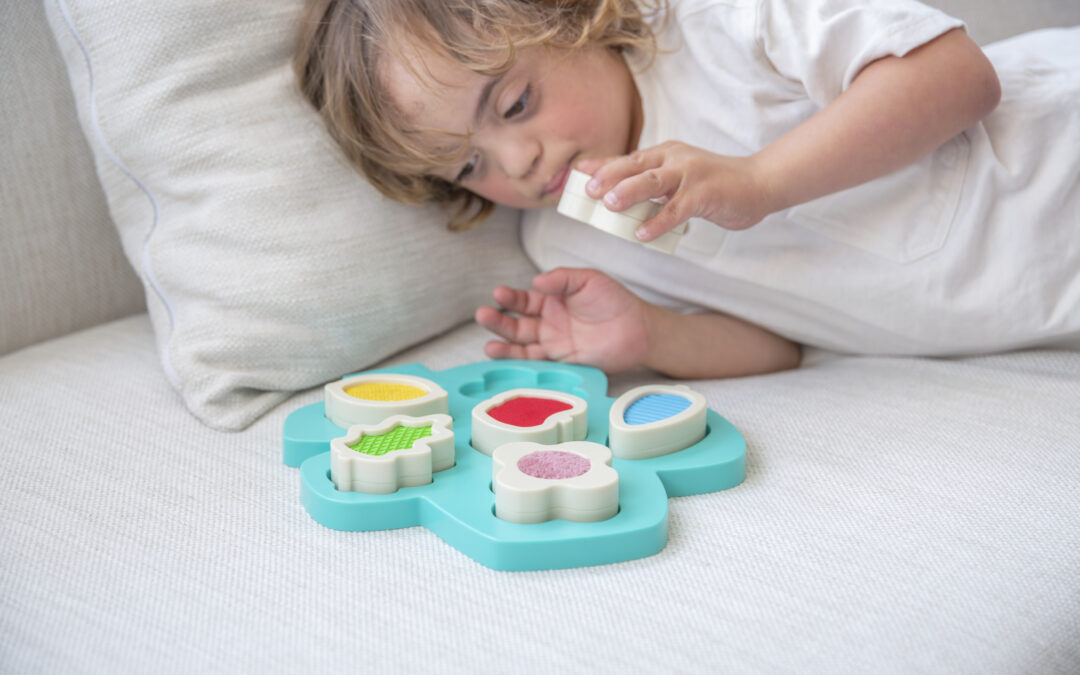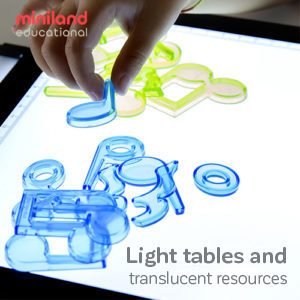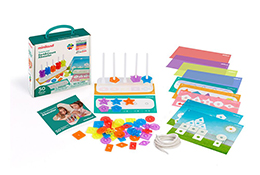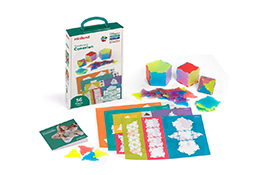A National Down Syndrome Society Guest Blog Post
by NDSS Research Associate Dana Sciullo, MOT, OTR/L
Play isn’t just fun—it is also the most effective way babies and toddlers learn and develop skills! Through play, little ones strengthen their bodies, practice purposeful movement of their heads, arms, legs, and hands, and are exposed to sensory input in ways that feel safe.
While all children develop at their own pace, research has shown that infants and toddlers who have Down syndrome tend to reach developmental milestones at later ages than their peers. This is all the more reason to engage in play!
One way parents and caregivers can support their little one’s development through play is to use toys that are engaging. When choosing an age-appropriate toy, consider the following:
- Is every part of the toy safe for the child to use? Are there any small parts or sharp edges?
- How can the child interact with the toy?
- Does the toy have bright, appealing colors?
- Does the toy make noise?
- How does the toy feel to the touch?
- Is the toy safe to put in the mouth?
- What skills are required of the child in order to interact with the toy? Are these skills that your child has or that would be appropriate for them to begin practicing? (If you’re not sure, ask an occupational therapist or visit the Center for Disease Control’s Developmental Milestones webpage at https://www.cdc.gov/ncbddd/actearly/milestones/index.html).
Infants Six Months or Younger
Infants six months old and younger will benefit from toys that encourage them to lay on their bellies for supervised “tummy time”, lift their head, focus their eyes, and reach their arm out. Toys should have bold, contrasting colors. Toys that make gentle noises, like rattles or crinkling, tend to be soothing. Toys with mirrors are appealing and can be used during “tummy time” to encourage the infant to hold the weight of their head up against gravity and focus on their reflection. There shouldn’t be any small parts or hard, sharp edges and toys should be easy to clean and safe for the mouth.

Miniland’s newest collection, Feel to Learn, features infant/toddler developmental toys like this Tulip Mirror that stimulates the sense of sight, hearing, and touch (with crinkly paper inside) in contrasting colors.
Infants Older than Six Months
Infants older than six months may enjoy toys that involve picking up and stacking, such as large, soft blocks or stacking rings. If the child is not yet sitting on their own, put them into a supported seated position to encourage play. Provide support to their torso as they reach to pick up items. Even if your little one isn’t ready to stack, they may enjoy throwing the items or banging two of them together. All of these activities are beneficial for learning beginning fine motor skills, the ability to move the arms and hands with control and precision.
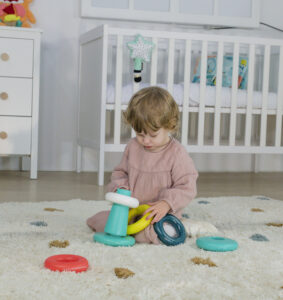
Feel to Learn’s Stack & Roll Rings aren’t your average, classic stacking ring game. Instead of a circle, they are in an oval shape, allowing babies & toddlers the opportunity to work on their visual stimulation, attention and hand-eye coordination. Little ones will have a great time stacking up the rings and then rolling it around when they’re done.
Did we mention they’re also made of eco-friendly materials
Toddlers
As the toddler approaches two and three years of age, they may be ready to play with toys that require a higher level of fine motor skill. When choosing toys, it is still appropriate to keep in mind the importance of engaging one or more of the senses. Shape sorters and very simple puzzles not only provide practice with arm, hand, and finger movements, but also add visual-spatial awareness as the toddler identifies the shape that fits in each opening and aligns the shape or puzzle piece to fit inside.
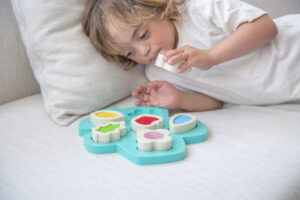
Miniland’s Feel to Learn Nestable Sensory Tree is the perfect toy to stimulate the senses! This tree-shaped game contains 6 pieces with nestable shapes and textures, fostering early sensory stimulation, hand-eye coordination, spatial vision and logic. Its shapes, textures and colors will also develop your child’s curiosity. Watch in amazement as they discover the different textures of each piece! Made of eco-friendly materials, too
When your child is feeling successful with the activities above, you may want to introduce tongs to their play activities. Tongs are similar to tweezers but larger and easier for small hands to grasp. They require a higher level of fine motor skill as well as strong muscles in the hands and fingers to open and close. When introducing tongs, be sure to provide assistance (and lots of verbal encouragement!) until the child is able to use them confidently by themself. Have the child experiment with the tongs by picking up items of different sizes and textures. Large, soft items tend to be easier to grip with tongs than tiny, hard items. Using tongs is a great way to prepare the muscles in the hands and fingers to hold a crayon or pencil.
Important Takeaways
- The most important thing to remember about playing with an infant or toddler is to keep it fun! If they aren’t excited to do a certain activity, try adjusting the activity or switching to a new activity altogether.
- Provide the child with two to three play options, then follow their lead.
- When choosing a toy, look for options that are safe, appealing to the senses, and involve skills your child is currently learning. Ask an occupational therapist for suggestions if you are unsure.
- Play sessions may be very short at first, and that is okay! As your child grows, they will enjoy playing for longer periods of time both independently and with others.
- Find ways to incorporate the child’s senses into play. This will attract and maintain their attention as well as provide exposure to various sensory input in a way that feels safe and secure.
- Not only will playtime help the child to develop skills, but it will give you and your little one plenty of opportunities to spend time together and strengthen your bond!
Dana Sciullo, MOT, OTR/L
Research Associate, National Down Syndrome Society
National Down Syndrome Society
Founded in 1979, the National Down Syndrome Society (NDSS) empowers individuals with Down syndrome and their families by driving policy change, providing resources, engaging with local communities, and shifting public perceptions. NDSS engages grassroots advocates at the federal, state, and local levels and creates resources to support individuals with Down syndrome, their families, and caregivers across the lifespan on topics including education, employment, health and wellness, and aging. NDSS founded the National Buddy Walk® Program in 1995 and hosts community engagement events throughout the country including the New York City Buddy Walk®and Times Square Video, the NDSS Adult Summit, and the Down Syndrome Advocacy Conference. Visit www.ndss.org to learn more.
References:
Elizabeth A. Will, Lisa A. Daunhauer, Deborah J. Fidler, Nancy Raitano Lee, Cordelia Robinson Rosenberg & Susan L. Hepburn (2019) Sensory Processing and Maladaptive Behavior: Profiles Within the Down Syndrome Phenotype, Physical & Occupational Therapy In Pediatrics, 39:5, 461-476, DOI: 10.1080/01942638.2019.1575320
